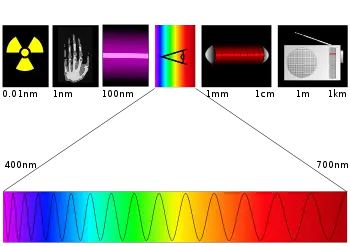Photochemistry
Photochemistry, a sub-discipline of chemistry, is the study of the interactions between atoms, small molecules, and light (or electromagnetic radiation).[1]
Like most scientific disciplines, photochemistry utilizes the SI or metric measurement system. Important units and constants that show up regularly include the metre (and variants such as centimetre, millimetre, micrometre, nanometre, etc.), seconds, hertz, joules, moles, the gas constant R, and the Boltzmann constant. These units and constants are also integral to the field of physical chemistry.
The first law of photochemistry, known as the Grotthuss-Draper law (for chemists Theodor Grotthuss and John W. Draper), states that light must be absorbed by a chemical substance in order for a photochemical reaction to take place.
The second law of photochemistry, the Stark-Einstein law, states that for each photon of light absorbed by a chemical system, only one molecule is activated for a photochemical reaction. This is also known as the photoequivalence law and was derived by Albert Einstein at the time when the quantum (photon) theory of light was being developed.
Photochemistry may also be introduced to laymen as a reaction that proceeds with the absorption of light. Normally a reaction (not just a photochemical reaction) occurs when a molecule gains the necessary activation energy to undergo change. A simple example can be the combustion of gasoline (a hydrocarbon) into carbon dioxide and water. This is a chemical reaction where one or more molecules/chemical species are converted into others. For this reaction to take place activation energy should be supplied. The activation energy is provided in the form of heat or a spark. In case of photochemical reactions light provides the activation energy.
The absorption of a photon of light by a reactant molecule may also permit a reaction to occur not just by bringing the molecule to the necessary activation energy, but also by changing the symmetry of the molecule's electronic configuration, enabling an otherwise inaccessible reaction path, as described by the Woodward-Hoffmann selection rules. A 2+2 cycloaddition reaction is one example of a pericyclic reaction that can be analyzed using these rules or by the related frontier molecular orbital theory.
Main concepts
The pillars of photochemistry are UV/VIS spectroscopy, photochemical reactions in organic chemistry and photosynthesis in biochemistry.
Regions of the electromagnetic spectrum
The electromagnetic spectrum is broad, however, a photochemist will find themselves working with several key regions. Some of the most widely used sections of the electromagnetic spectrum include:
- Visible Light: 400–700 nm wavelengths
- Ultraviolet: 100–400 nm wavelengths
- Near Infrared: 700–1000 nm wavelengths
- Far infrared: 15–1000 µm wavelengths
See also
- Photoelectrochemical cell
- Photochemical and Photobiological Sciences
ReferencesISBN links support NWE through referral fees
- ↑ International Union of Pure and Applied Chemistry. "photochemistry". Compendium of Chemical Terminology Internet edition.
| ||||||||
ar:كيمياء ضوئية bg:Фотохимия cs:Fotochemie de:Fotochemie el:Φωτοχημεία es:Fotoquímica fr:Photochimie id:Fotokimia is:Ljósefnafræði it:Fotochimica he:פוטוכימיה hu:Fotokémia nl:Fotochemie ja:光化学 pl:Fotochemia pt:Fotoquímica ru:Фотохимия fi:Valokemia sv:Fotokemi th:เคมีแสง zh:光化学
